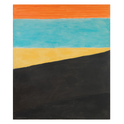I have just spent an afternoon and the following morning with German filmmaker and writer Wim Wenders. A retrospective of his movies has just finished at the BFI Southbank in London and the Filmhouse in Edinburgh. Two of them—Alice in the Cities (1974) and Land of Plenty (2004)—are being released here for the first time. Spending time with him sent me on a train of thought about his cinema and my life.
Alice in the Cities, a road movie about a German man and a nine-year-old girl, was the first Wenders movie I saw, on a course at university in 1983. I still remember the opening sequence. The camera cranes down from a wooden walkway to actor Rüdiger Vogler sitting below it, alone, on a beach, singing "Under the Boardwalk." I knew the Drifters' version of the song, of course, but only in that scene did I realise what a boardwalk actually was. I hadn't travelled much at that stage or, rather, I'd done so only through the proxy of cinema. Like most westerners born in the era of mass culture, American clothes, slang, songs, imagery, attitudes, movies, food, buildings and ideas were familiar to me but perhaps, like boardwalks, in an empty way.
I adored Alice in the Cities (pictured, below right, with Rüdiger Vogler and Yella Rottländer) in 1983. At one point Vogler, who's driving around America, staying in cheap hotels, snapping everything with a Polaroid camera, says that he takes photographs not to speak, but to listen. Though I was only 18 then, I loved the daring idea that art—even if it was just a Polaroid—might not be about self-expression, but about paying attention. Soon afterwards I saw Wenders's Kings of the Road (1976), another road movie starring Vogler, and was shocked when one of the characters squats by the roadside and defecates, in full view of the camera. Its European insolence punctured the decorum of entertainment cinema.

By Wings of Desire (1987), Wenders's poetics had become more outré. I loved the film, but somewhat less so than others. Two years later, in October 1989, I found myself working in Berlin, where Wings of Desire was set, as the wall came down. For the first time in my life, I was having experiences more intense than cinema. The traveller in me had overtaken the traveller in it. In the years since, cinema's wanderlust and my own have intersected often, as in the ending of Kings of the Road, where the two men, one in a van, one on a train, criss-cross each other's tracks. I fell hard for Iranian cinema after I'd been to Iran, for example, yet I am passionate about Senegalese movies without ever having been to the country.
From Wings of Desire onwards, I felt that Wenders had started talking rather than listening. His 1990s movies, including Until the End of the World (1991), Faraway, So Close (1993) and The End of Violence (1997), were full of heart, but also sounded to me like a waterfall of words. Wenders was more in focus for me in documentaries such as Notebook on Cities and Clothes (1989), Tokyo-Ga (1985) and Buena Vista Social Club (1999). The latter's huge success helped make the ne'er-do-well genre of non-fiction film, which had become the way I earned my crust, commercially successful in cinemas for the first time since the birth of the movies.
In 2000, under the influence of Wenders's road movies, I bought a camper van and drove to India via Iran. Then, fast forward to 2008, when Wenders walked into the green room of the BFI Southbank, sporting a ponytail. He spoke slowly and almost in a whisper. We filmed him, fly-on-the-wall style, for a forthcoming documentary series as he talked to students and was interviewed by Sky TV. That night, I watched Alice in the Cities again. Not a frame of it seemed wrong to me. The film industry is obsessed by the idea of "back story" for its characters. Vogler has almost none in the film, yet is entrancing. Alice in the Cities is committed to capturing the present tense, what Geoff Dyer calls "the ongoing moment." It isn't driven by story so much as itinerary. In the opening scene, when Vogler sang "Under the Boardwalk," I cried.
When we interviewed him the next morning, Wenders's voice had become even quieter. I felt that we were intruding. But through the reticence, I thought I glimpsed something like idealism. He said that for Europeans of his age, America was utopia until you went there. I asked him if it had ever made him cry. Yes, he said, when he last visited Monument Valley, where John Ford shot some of his famous westerns, and discovered that it had become a theme park. I asked about the relationship between Vogler and the nine-year-old girl in Alice, played by Yella Rottländer. Wenders said that he works with young people in the hope that some of their idealism will rub off on him. While shooting Alice, he gave Rottländer the right to say "cut" if she didn't like the scene. This is almost unique, and may be linked to Wenders's commitment to teaching which, in turn, is linked to his long-running presidency of the European Film Academy.
We wrapped up our interview at 1pm. Afterwards, I walked across London for five hours in a daft tribute to Wenders. He'd told me that he didn't know what a boardwalk was until he saw the one that he filmed in Alice. Places tell stories, he said. There's a close link, as Herr Wenders knows better than any other filmmaker, between motion and emotion.











